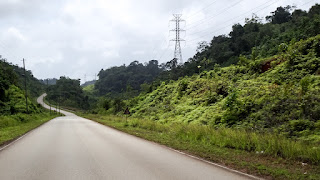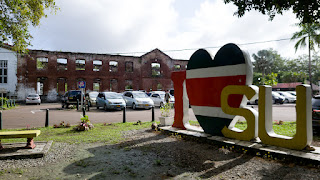Suriname - Almost nobody knows this country

The scenic flight from Guyana to Suriname lasted about 1.5 hours. Initially, it was uncertain if the small Cessna airplane would take off, especially because of the strong winds in Guyana. Flights with such small planes often get re-scheduled or canceled.
It was only after I sat in the small aircraft with six other passengers and an Indian pilot, that I got convinced that the flight would take place. This particular airline "Transguyana" is known for canceling flights just hours before departure for unknown reasons, and even flight tracking websites do not provide reliable information on whether the flights have been punctual or even started in the past. Furthermore, the flight numbers did not match.
However, the flight turned out to be a nice journey from Guyana to Paramaribo, Suriname's capital city, along the northern coast of the South American continent. The Indian pilot even continuously took pictures for himself throughout the flight.
Not sure if it was perfect weather for photos today or if the pilot was on his first flight.
Paramaribo is split by the huge Suriname River. The only way to pass the river is a relatively newly built bridge or a ferry. I didn't know about the ferry up until I reached the other side and after crossing the bridge but that wasn't a big issue as the drive was comfortable on good roads.
I continued to "Suikerrietplantage Mariënburg", which was another 20 minutes drive away.
The future of tourism in Suriname?
For Suriname, there are basically only a couple of large international flights every day to and from the large international airport "Johan Adolf Pengel International Airport". This shows again how few people come to visit or work in this country, especially when comparing it with its neighbor Brazil.
I'm wondering how this country will be in 10 years, for example, if all the colonial houses where people live in nowadays will still exist? Probably not, as hurricanes take those wooden houses away in hundreds every single year and the people don't have the money to restore them fully.
It's an unknown country
This country is so unknown it's unbelievable. Most people don't even know that it exists and even fewer know where it is located (most asking: Oh you're going to Africa?).
Surely Suriname will attract the attention of many tourists in the future, especially those nature people. Even with the huge lack of money, the country has made some efforts to develop tourism, promote travel and make advertisements for their natural resources and Suriname's tourism industry is still in its early stages. But this country surely has the potential to become a great alternative for traveling and avoiding the masses in its more famous neighbors like Colombia, Brazil, and Ecuador.
Arriving in Suriname's small city center airport
The flight landed on time in the afternoon at the small airport "Zorg En Hoop Airport" in the middle of Parmaribo. At this small airport, only small aircraft like Cessna's are allowed to land.That was convenient as the large international airport is more than an hour's drive away.
The rental car was in excellent condition, fully fueled, and clean, just as one would wish. And the rental cost for four days was only 142 USD.
The road was well-paved, and there was little traffic.
After two hours, I arrived in Braunsweg and asked around if someone could drive me to Braunsberg because the small 2WD could not pass the road.
I continued driving to "Berg en Dal" and then to Brokopondo, Afobaka, and the Brokopondo Lookout.
I did not expect Suriname to have a dam of this size, and the view from the hill next to the dam was also very beautiful.
From there, I drove north again. For an hour, heavy rain set in, which fortunately washed the rental car clean again.
One hour before reaching Paramaribo, I came across a public beach called "White Beach" on the Suriname River. The facility was well-maintained, and the access to the river was safely designed.
Immigration was quick with only six passengers. Interestingly, Dutch is spoken here in Suriname, which is quite unique to hear this language in such a remote country.
Rental cars are cheap in Suriname
Upon arrival, the car rental was already waiting. However, there was a small mix-up, as the person confused me with someone else. I thought it was the car rental person picking me up and taking me to the office. After a two-minute drive, the man asked me on which ship I would be working. Then it became clear to me that he had the wrong person in the car. We went back to the airport, where the right person was waiting, who had been requested but not picked up, and also the rental car staff.
The rental car was in excellent condition, fully fueled, and clean, just as one would wish. And the rental cost for four days was only 142 USD.
Drove to the apartment in the city center of Paramaribo. The buildings looked interesting, all still originating from colonial times. And people still live in here.
The roads are in great condition for such a poor country.
When driving further south the streets may have some potholes but not problematic at all.
Day 2 - So much jungle everywhere
Departed early in the morning to Braunsweg and then to Braunsberg. That was my plan. The route to Braunsweg, a small village with access to Braunsberg, was 120 km and took about 2.5 hours.The road was well-paved, and there was little traffic.
The scenery became nicer with every kilometer, with more and more rainforest and Amazon on both sides of the road.
There is probably a no more comfortable way to see the rainforest of South America. Simply driving through the forest with a car, covered from mosquitos, rain and sun. Perfect.
After two hours, I arrived in Braunsweg and asked around if someone could drive me to Braunsberg because the small 2WD could not pass the road.
Several people tried to help and find someone with a 4WD by phone, but the answer was always the same. With the weather conditions and the muddy road, even a 4WD would not be able to go up the muddy hills.
Then I asked the police, who discussed and asked their superiors if they could drive me to Braunsberg on a "police patrol".
Apparently, they wanted to make a trip themselves instead of sitting around all the time. Unfortunately, that did not work, and they also told me that the route was too difficult these days because of heavy rain.
I continued driving to "Berg en Dal" and then to Brokopondo, Afobaka, and the Brokopondo Lookout.
I did not expect Suriname to have a dam of this size, and the view from the hill next to the dam was also very beautiful.
From there, I drove north again. For an hour, heavy rain set in, which fortunately washed the rental car clean again.
Otherwise, I would have had to pay for cleaning it myself due to the dirt.
One hour before reaching Paramaribo, I came across a public beach called "White Beach" on the Suriname River. The facility was well-maintained, and the access to the river was safely designed.
A fence was erected ten meters from the shore to protect guests from anacondas and piranhas and prevent them from drifting away in the river.
Like all the waters in Suriname, the river was as brown as coffee. After the visit, I returned to Paramaribo to see the Waterkant.
Waterkant is Waterfront and it's the city center with most governmental buildings.
Day 3 - So many dutch forts and sugar cane plantations
Planned to see the other side of the river to see the colonial dutch waterfront forts. The first would be "Fort Nieuw Amsterdam".
I reached the fort after an hour.
Even though it looks like it's located just beside the city center, it takes quite a long time to get there. Along the way, I saw several tourists which looked extremely dutch, especially as all of them were riding dutch-type bicycles.
This fort was built back in 1750 by the dutch. It was supposed to protect Paramaribo from ships entering the river and docking in downtown Paramaribo.
I continued to "Suikerrietplantage Mariënburg", which was another 20 minutes drive away.
That place is the most famous sugar cane plantation. Along the road again, many dutch people with bicycles. Interesting species those dutch, looks like they bring their bicycles everywhere.
Marienburg sugar cane plantation
This "Marienburg" is definitely a great piece of history and colonial times.
It may look sad as it is all rundown. Unfortunately, some old people who used to work here back in the days as sugar cane farmers told me, there is no money foreseen to keep the buildings up in good condition.
It's sad that heritage is treated like this. This means these buildings will collapse in the next few years or when one of the next hurricanes arrives. Even all along the way are many resident houses that look like they collapse in the next rainy weather.
Day 4 - Downtown Paramaribo
So I had another leisurely day and it was finally a sunny day to see the city center. All these interesting buildings are within the center and beside them is a huge palm tree park.
Just next to it are many restaurants and also the "Fort Zeelandia".
I wasn't aware what this thing is about but it was some fort to protect the "ruler" back in colonial times.
Didn't want to spend a long time here and also didn't want an annoying guide. Unfortunately, it's difficult though to find out some facts on the site as everything is mostly written in dutch.
There were many more colonial fortresses and sugar cane farms, or relics of these colonial times. But the rain started to set in and I drove back through the colonial streets in Paramaribo.
Day 5 - Departure from "Johan Adolf Pengel International" Airport
Day of departure. My flight was in the afternoon.
Until then I needed to bring back the rental car somewhere downtown. Luckily the rental car company offered me to give a lift all the way to the international airport which was 1.5 hours from Paramaribo.
Busy airport, but almost no flights
Even though there were only two flights planned this afternoon and for the rest of the day, the airport was overloaded with people.
Extremely long lines at check-in and security, but not because of the number of passengers, but more because of the lack of personnel working there.
Finishing a 7 weeks Caribbean trip
I had plenty of time to wait and finally, the plane went off toward Europe as expected. That was the end of this 7-week Caribbean trip and now as of 2023, the Dominican Republic, Haiti and Venenzela are left to be visited in the continents of North and South America.



















































































Post a Comment